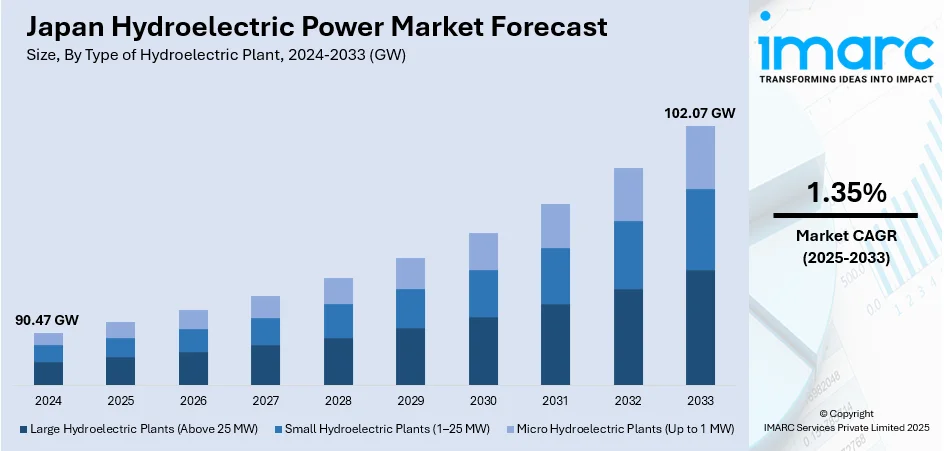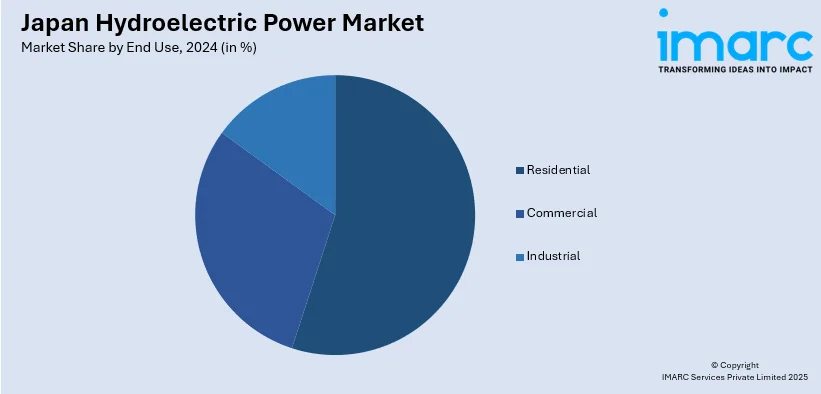
Japan Hydroelectric Power Market Size, Share, Trends and Forecast by Type of Hydroelectric Plant, Component, End Use, and Region, 2025-2033
Japan Hydroelectric Power Market Overview:
The Japan hydroelectric power market size reached 90.47 GW in 2024. Looking forward, IMARC Group expects the market to reach 102.07 GW by 2033, exhibiting a growth rate (CAGR) of 1.35% during 2025-2033. Government policies promoting renewable energy, a push for energy security, environmental concerns, and technological advancements are some of the factors contributing to Japan's hydroelectric power market share. Additionally, Japan's efforts to reduce reliance on fossil fuels and meet carbon-neutral goals fuel the growth of the hydroelectric sector.
|
Report Attribute
|
Key Statistics
|
|---|---|
|
Base Year
|
2024
|
|
Forecast Years
|
2025-2033
|
|
Historical Years
|
2019-2024
|
| Market Size in 2024 | 90.47 GW |
| Market Forecast in 2033 | 102.07 GW |
| Market Growth Rate 2025-2033 | 1.35% |
Japan Hydroelectric Power Market Trends:
Growth in Hydroelectric Partnerships for Renewable Energy Expansion
In Japan, hydroelectric power markets are increasingly seeing collaborations aimed at optimizing existing water resources for renewable energy generation. New alliances are focused on replacing aging infrastructure with modern, efficient systems to increase capacity and sustainability. These partnerships emphasize harnessing local water resources to support national carbon neutrality goals. The ongoing shift towards large-scale hydroelectric ventures is helping countries diversify their renewable energy sources, reduce reliance on fossil fuels, and meet ambitious emissions reduction targets. As the market evolves, further investments are expected in upgrading existing facilities and developing new ones to ensure long-term environmental and energy security. These factors are intensifying the Japan hydroelectric power market growth. For example, in February 2024, Mitsubishi Corporation and Hokkaido Electric Power Company launched the Ainumanai Power Plant, marking the start of their hydroelectric alliance in Japan's Donan region. The new venture, Donan Hydroelectric LLC, replaces Hokuden's five existing plants. With a focus on optimizing renewable energy, the partnership would support Japan's carbon neutrality goals by leveraging regional water resources. Further plants in the region are set to come online as replacement work progresses.

To get more information on this market, Request Sample
Hydroelectric Power Advancements in Japan's Renewable Energy Strategy
Collaborations are driving significant advancements in Japan’s hydroelectric sector, with a focus on upgrading outdated infrastructure. By replacing older plants with more efficient systems, these initiatives aim to optimize local water resources, ensuring a steady and sustainable power supply. The shift towards modern hydroelectric solutions aligns with Japan’s ambitious goals for carbon neutrality. As new plants are brought online, the country is making strides in reducing its reliance on fossil fuels while bolstering renewable energy generation. These efforts also highlight the role of hydropower in achieving energy security and environmental sustainability. Through continued investment and innovation, Japan is strengthening its position in renewable energy markets and progressing towards a carbon-neutral future. For instance, in May 2024, NTT Docomo launched Japan's first demonstration of a self-powered hydropower cellular base station. This experiment uses water from irrigation canals to generate electricity through a jet turbine developed by Professor Yukihiro Shimatani. The system aims to provide sustainable power for mobile networks in rural areas. Docomo plans to implement this technology as part of its goal for net-zero greenhouse gas emissions by 2030. The project complements Docomo's green base stations powered by solar energy.
Japan Hydroelectric Power Market Segmentation:
IMARC Group provides an analysis of the key trends in each segment of the market, along with forecasts at the regional level for 2025-2033. Our report has categorized the market based on type of hydroelectric plant, component, and end use.
Type of Hydroelectric Plant Insights:
- Large Hydroelectric Plants (Above 25 MW)
- Small Hydroelectric Plants (1–25 MW)
- Micro Hydroelectric Plants (Up to 1 MW)
The report has provided a detailed breakup and analysis of the market based on the type of hydroelectric plant. This includes large hydroelectric plants (above 25 MW), small hydroelectric plants (1–25 MW), and micro hydroelectric plants (up to 1 MW).
Component Insights:
- Turbines
- Generators
- Transformers
- Control Systems
A detailed breakup and analysis of the market based on the component have also been provided in the report. This includes turbines, generators, transformers, and control systems.
End Use Insights:

- Residential
- Commercial
- Industrial
A detailed breakup and analysis of the market based on the end use have also been provided in the report. This includes residential, commercial, and industrial.
Regional Insights:
- Kanto Region
- Kansai/Kinki Region
- Central/Chubu Region
- Kyushu-Okinawa Region
- Tohoku Region
- Chugoku Region
- Hokkaido Region
- Shikoku Region
The report has also provided a comprehensive analysis of all the major regional markets, which include Kanto Region, Kansai/Kinki Region, Central/Chubu Region, Kyushu-Okinawa Region, Tohoku Region, Chugoku Region, Hokkaido Region, and Shikoku Region.
Competitive Landscape:
The market research report has also provided a comprehensive analysis of the competitive landscape. Competitive analysis such as market structure, key player positioning, top winning strategies, competitive dashboard, and company evaluation quadrant has been covered in the report. Also, detailed profiles of all major companies have been provided.
Japan Hydroelectric Power Market News:
- In March 2025, Indonesia signed a letter of intent with Japan to develop the Kayan hydropower plant in North Kalimantan. This strategic project, with a capacity of 9,000 MW and an investment of USD 17.8 Billion, would support Indonesia's energy security and decarbonization efforts. Once completed, the plant would power the largest green industrial park in Southeast Asia, helping the country meet its renewable energy targets of 23% by 2025 and 31% by 2050.
Japan Hydroelectric Power Market Report Coverage:
| Report Features | Details |
|---|---|
| Base Year of the Analysis | 2024 |
| Historical Period | 2019-2024 |
| Forecast Period | 2025-2033 |
| Units | GW |
| Scope of the Report |
Exploration of Historical Trends and Market Outlook, Industry Catalysts and Challenges, Segment-Wise Historical and Future Market Assessment:
|
| Type of Hydroelectric Plants Covered | Large Hydroelectric Plants (Above 25 MW), Small Hydroelectric Plants (1–25 MW), Micro Hydroelectric Plants (Up to 1 MW) |
| Components Covered | Turbines, Generators, Transformers, Control Systems |
| End Uses Covered | Residential, Commercial, Industrial |
| Regions Covered | Kanto Region, Kansai/Kinki Region, Central/Chubu Region, Kyushu-Okinawa Region, Tohoku Region, Chugoku Region, Hokkaido Region, Shikoku Region |
| Customization Scope | 10% Free Customization |
| Post-Sale Analyst Support | 10-12 Weeks |
| Delivery Format | PDF and Excel through Email (We can also provide the editable version of the report in PPT/Word format on special request) |
Key Questions Answered in This Report:
- How has the Japan hydroelectric power market performed so far and how will it perform in the coming years?
- What is the breakup of the Japan hydroelectric power market on the basis of type of hydroelectric plant?
- What is the breakup of the Japan hydroelectric power market on the basis of component?
- What is the breakup of the Japan hydroelectric power market on the basis of end use?
- What is the breakup of the Japan hydroelectric power market on the basis of region?
- What are the various stages in the value chain of the Japan hydroelectric power market?
- What are the key driving factors and challenges in the Japan hydroelectric power market?
- What is the structure of the Japan hydroelectric power market and who are the key players?
- What is the degree of competition in the Japan hydroelectric power market?
Key Benefits for Stakeholders:
- IMARC’s industry report offers a comprehensive quantitative analysis of various market segments, historical and current market trends, market forecasts, and dynamics of the Japan hydroelectric power market from 2019-2033.
- The research report provides the latest information on the market drivers, challenges, and opportunities in the Japan hydroelectric power market.
- Porter's five forces analysis assist stakeholders in assessing the impact of new entrants, competitive rivalry, supplier power, buyer power, and the threat of substitution. It helps stakeholders to analyze the level of competition within the Japan hydroelectric power industry and its attractiveness.
- Competitive landscape allows stakeholders to understand their competitive environment and provides an insight into the current positions of key players in the market.
Need more help?
- Speak to our experienced analysts for insights on the current market scenarios.
- Include additional segments and countries to customize the report as per your requirement.
- Gain an unparalleled competitive advantage in your domain by understanding how to utilize the report and positively impacting your operations and revenue.
- For further assistance, please connect with our analysts.
 Request Customization
Request Customization
 Speak to an Analyst
Speak to an Analyst
 Request Brochure
Request Brochure
 Inquire Before Buying
Inquire Before Buying




.webp)




.webp)












